Best Indoor Soccer Formations – 6 vs 6 Format
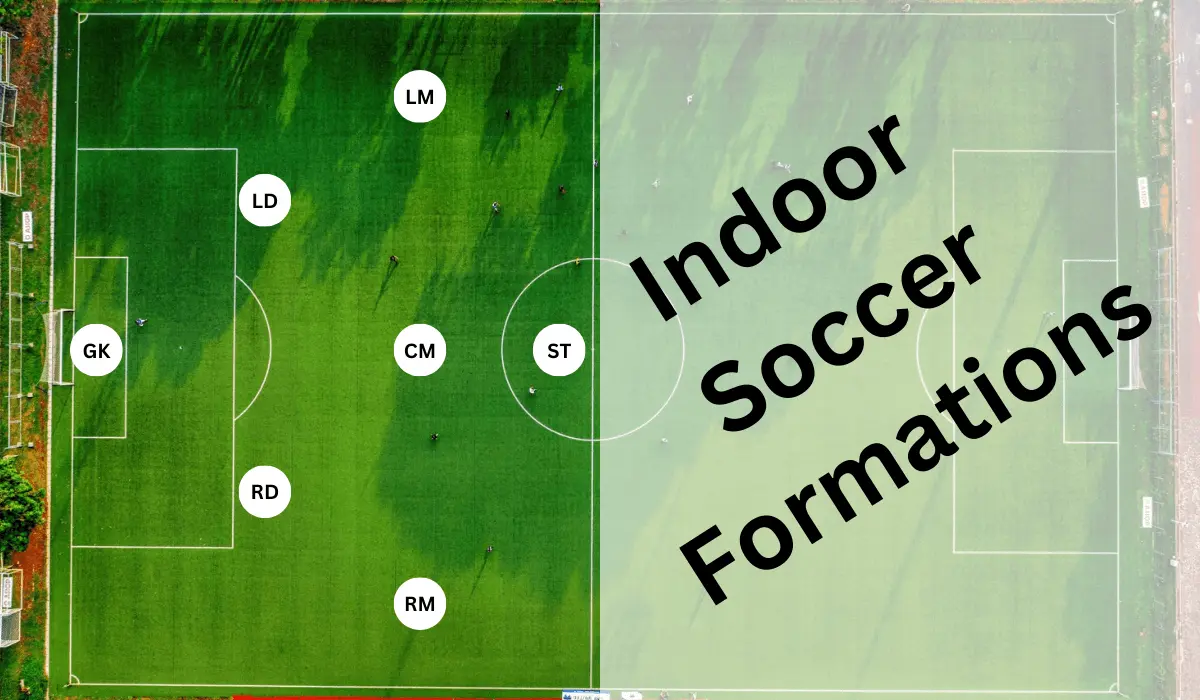
Forget grass stains, indoor soccer is where it’s at! Think lightning-fast sprints, wall-defying maneuvers, and goals exploding off every bounce. But mastering this court needs more than fancy footwork – you need a formation.
Think of it as your secret weapon, a puzzle where each teammate is a vital piece. Let’s crack the code with some top formations:
Defensive Fortress (2-2-1)
Imagine brick walls and fierce dragons. This rock-solid setup, like Baltimore Arena’s defense, has two defenders guarding the gates and two midfielders patrolling the middle. Think Messi lurking in the shadows, waiting for the perfect counter-attack. Ideal for teams built on grit and tactical smarts.
Balanced Armada (2-3-1)
Picture warships cutting through waves, adaptable and powerful. This formation, like San Diego Sockers’ midfield, blends offense and defense with two defenders, three midfielders controlling the tempo, and a lone striker leading the charge. Perfect for well-rounded teams with a hunger for goals.
All-Out Blitz (1-3-2)
Imagine a Formula One race car, sleek and unstoppable. This formation lives by the motto “Attack is the best defense.” One lone defender anchors the back, while three midfielders orchestrate the attack, leaving two strikers ready to finish the job. Think of Franck Tayou’s electrifying speed tearing down the flanks who’s one of these 2 strikers. Ideal for teams with exceptional passing and goal-scoring skills.
But remember, that
“right” formation is a myth.
You and your team need to experiment, analyze, and adapt based on your strengths and weaknesses. So grab your playbook, gather your teammates, and become the architects of your on-court masterpiece! Conquer the indoor soccer maze and write your own epic victory story!
List of Formation 5 vs 5, 6 vs 6, 7 vs 7 in Indoor Soccer
Indoor soccer is played with reduced team sizes and limited space compared to the full 11 v 11 outdoor soccer. The amount of space and players on the field have a major impact on selecting an appropriate formation.
5v5 play features tight spaces similar to futsal. Formations like the 1-2-1 and 2-1-1 provide balance with 1-2 strikers, 1-2 midfielders, and 1-2 defenders.
6v6 opens up more possibilities with the extra player. Popular formations like the 2-2-1 and 2-1-2 leverage 2 midfielders, 1-2 defenders, and 1-2 strikers.
7v7 allows for even more versatility. The 2-3-1 and 3-2-1 are common with their strength through the midfield. An extra attacker or defender can be added compared to 6v6.
Mostly Used Indoor Soccer Formations
| Format | Formations | Overview |
|---|---|---|
| 5 vs 5 |
|
Focus on balancing 1-2 defenders, midfielders, and strikers. Excellent for tight spaces. |
| 6 vs 6 |
|
Creative shapes with overloaded midfield or attack. Can provide unique advantages. |
| 7 vs 7 |
|
The extra player allows for a strengthened midfield or attack. Great versatility. |
Let’s look at various formations for 5v5, 6v6, and 7v7 indoor soccer. We will examine the pros and cons of each shape, as well as key tactical considerations for both attacking and defending formations.
Whether you are a player, coach, or spectator, understanding indoor soccer formations is crucial to getting the most out of the unique indoor game because after understanding the formations you’ll be able to understand the game more appropriately.
5 vs 5 Indoor Soccer Formations
The 5v5 format is most commonly seen in futsal, the official FIFA indoor soccer game. With only 5 players on the field, including the goalkeeper, formations focus heavily on balance and spacing. Futsal players must be very quick and good at exploiting spaces against opponents.
There are some possible 5 vs 5 formations that you can think of and apply practically in the game because I’ve done it while I used to play in college. As time progresses Futsal as well as indoor soccer is becoming more and more technical and advanced. So you need to understand it in a better way.
1-2-1 Formation
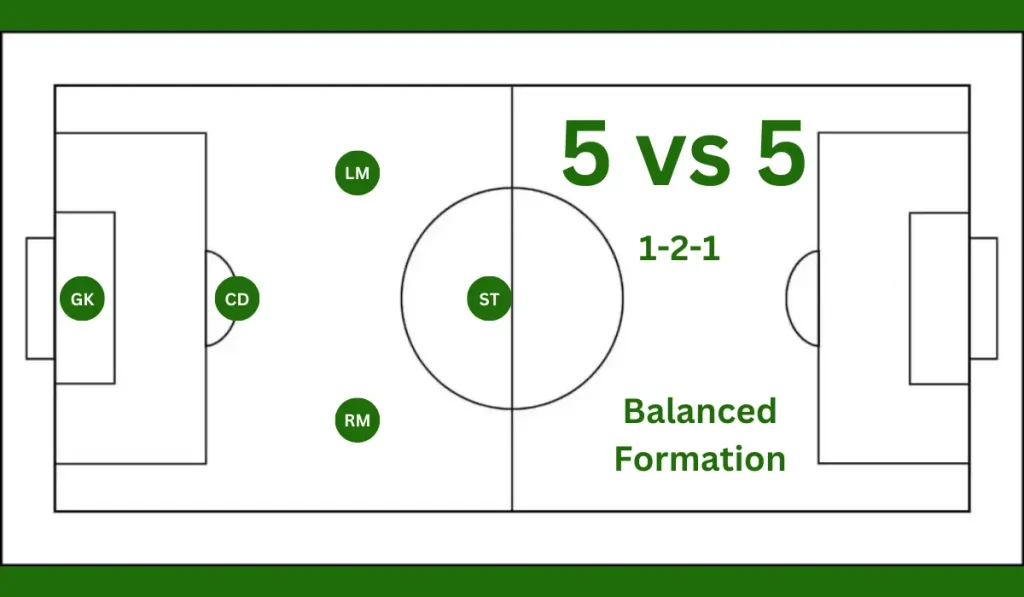
The 1-2-1 formation provides a good equilibrium between attack and defense because it’s a balanced approach. This formation should be used in a competitive match where you want to win it but never want to lose it in any way so you don’t take risks and go all out attacking.
With two midfielders, you can control possession and advance the ball effectively. In this formation possession is the key so midfielders should be mature enough not to pass the ball casually otherwise it’ll cost a goal.
You’ve got only one defender at the back who’ll be exposed if you try to play selfish or start doing extra dribbling this last defender is a playmaker who’s responsible for helping you keep possession of the ball and help you rotate around each other to make spaces and play quality passes.
Midfielders in this formation are the center of gravity because the game plan relies on them to support attack defense so they need to be physically top class and experienced played having a percentage of making mistakes is minute.
Keep this in mind communication is the key so midfielders should always be in communication with the defender and also the striker who’s there to shut their defenders up and also keep on shooting the ball at the goalkeeper as well as dribbling past defenders and finishing the ball in the net.
Striker should be physically best to compete with strong defenders also he needs to be brave and put in tackles if he sees an opportunity that can be converted into a goal.
1-3-0 Formation
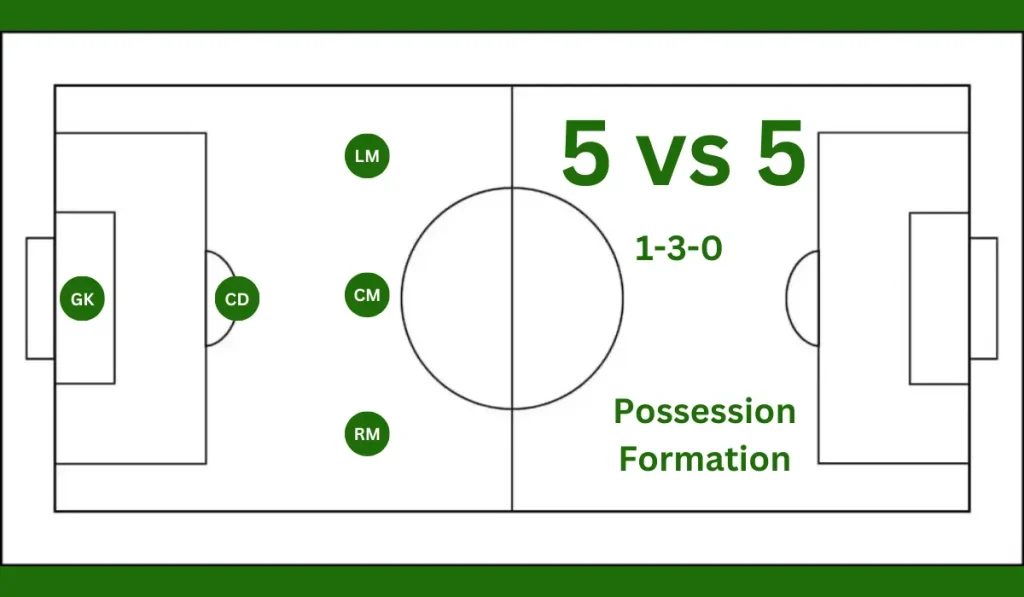
Overloading the midfield, the 1-3-0 is an ultra-attacking shape:
This is one of the possession-based formations in which you want your team to dominate the game based on midfield so you just make midfield crowded and aim to keep the ball. If you’ll keep the ball ultimately you’ll be able to set the pace of the game according to the need of the game.
For example, if your team is winning you’ll want the game to be dead so that opponents are unable to make any chances losing the game you’ll always plan to speed up the game to create chances and make your opponents make mistakes.
You’ve sacrificed a defined striker for a third midfielder. This packs the middle with technical players who can pass well in tight spaces. If you’ll make the midfield crowded you’ll dictate the pace of the game. So you can do innovative passes and create opportunities for your team to be in a better position.
The lack of a striker means you need midfielders to join the attack dynamically anyone of the midfielders can be the one who’ll strike because here every midfielder should be able to play the role of a striker means he should possess the required skills like fierce shooting, dribbling and scoring goals.
Defensively, you are vulnerable with only one defender. So midfielders should be very ready to help the defender out in almost every attack by the opposition otherwise he’ll be exploited as a result it’ll cost the team goals against them.
2-1-1 Formation

The 2-1-1 setup provides more balance:
This is a defensive formation means it’s applied when your team has already scored 2 goals Half of the match is left or even scored a goal and the last minutes are running. Then you should make your team defensive and keep possession of the ball.
Having a spare defender provides more security at the back. The midfielder links play between the defense and the lone striker. Here you’re already winning so you just need to keep the opponents from scoring against you. This formation is mostly used in a very competitive match like in the semifinal or the finals of tournaments.
With both a midfielder and striker to contend with, this formation poses an attacking threat but isn’t as risky defensively as the 1-3-0 shape. So this is a kind of reliable formation for teams that want to win the matches without having the risk of losing them.
One thing should be strictly followed to keep smart passing top-notch in a confined space and make multi-dimensional passes to exploit your opponents and make them pay on their loose ends intelligently.
6 vs 6 Indoor Soccer Formations
The 6 vs 6 format, including goalkeepers, is one of the most common versions of indoor soccer. The reduced space compared to the full 11v11 outdoor game allows for unique formations that focus on balance rather than defined positions. Let’s explore some of the most popular and effective 6v6 formations in more detail:
2-2-1 Formation
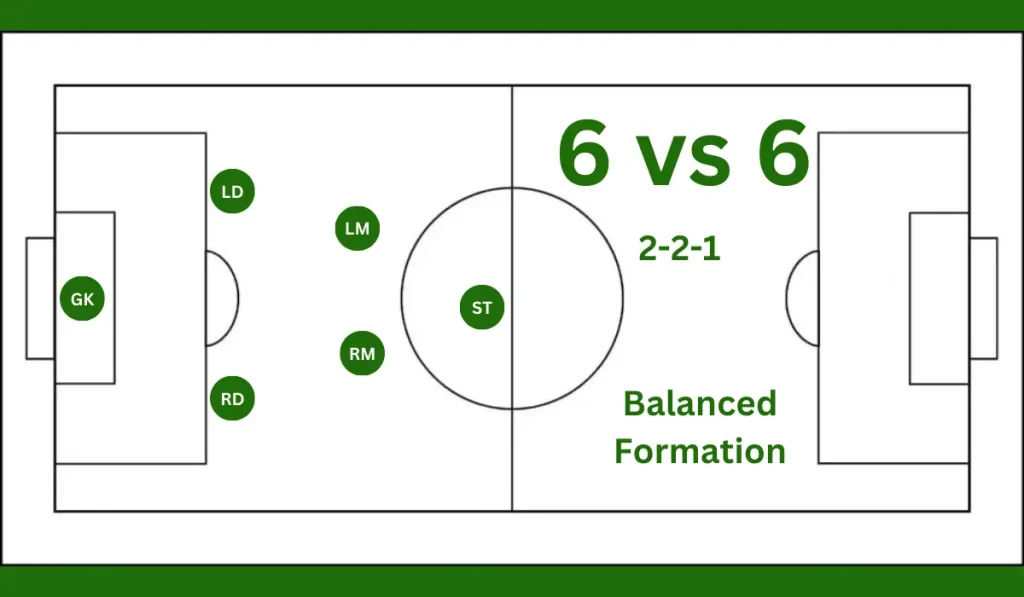
The 2-2-1 formation is considered one of the standard and balanced options for 6v6 indoor soccer. The lineup includes:
- 2 Defenders – Their main role is to protect the goal and prevent scoring chances. They should focus on marking opponents tightly in the box and clearing dangerous crosses.
- 2 Midfielders – The midfielders support both the attack and defense. They need to provide passing options to build up play, but also recover quickly when possession is lost. Communication with the defenders is vital to maintaining shape.
- 1 Striker – The lone striker will operate mainly in the offensive half looking to penetrate the opposing back line. With no offsides rule, the striker can situate high up the field in hopes of getting onto the end of through balls or winning second balls.
This formation provides a good equilibrium between defense and midfield support. The main drawback is the midfield can get stretched too thin if they push too far forward and the team will lose its grip on ruling midfield.
2-1-2 Formation
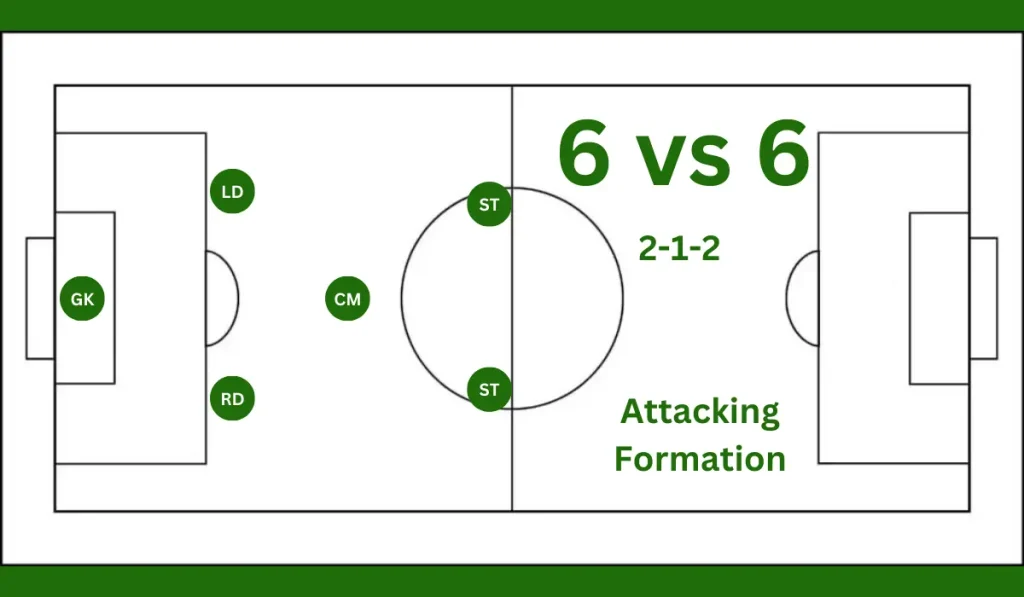
The 2-1-2 setup sacrifices a midfielder for an extra attacking player:
Having two strikers gives you added scoring threats up top and allows for interplay between the forwards. However, it puts a lot of responsibility on the lone midfielder to link defense and attack.
The midfielder will need to choose smart moments to push forward and support the strikers, while also recovering quickly to shore up the back line. Communication between the midfielder and defenders is essential to provide balance.
1-3-1 Formation
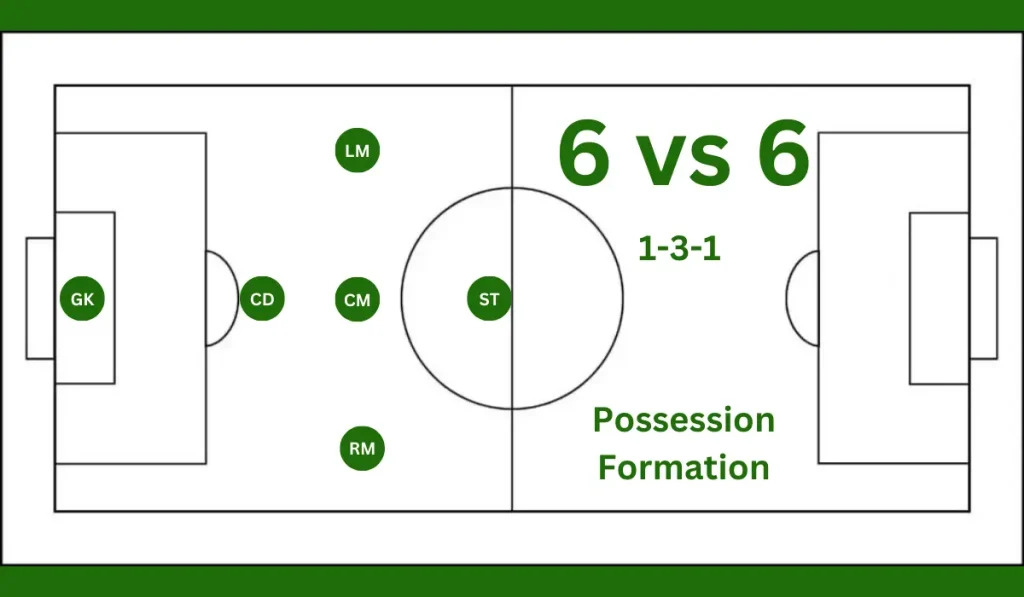
This formation flips the setup, overloading the midfield:
The three midfielders will dominate possession and offer angles to advance the ball upfield. The striker provides an attacking outlet while the defender protects the goal.
The main risk is if the ball is lost in midfield, the opponent has a lot of space to counter with only one defender. The midfielder’s transition speed back to defense is crucial to making this formation work.
There are tradeoffs with each approach, but hopefully, this provides more context on executing some of the top 6v6 indoor soccer formations effectively. Overloading offense or defense each has its risks and rewards!
7 vs 7 Indoor Soccer Formations
Seven-a-side indoor soccer utilizes two additional players compared to the 6v6 format. Those extra players allow for more versatility in formations and tactics. Let’s look at some top options:
2-3-1 Formation
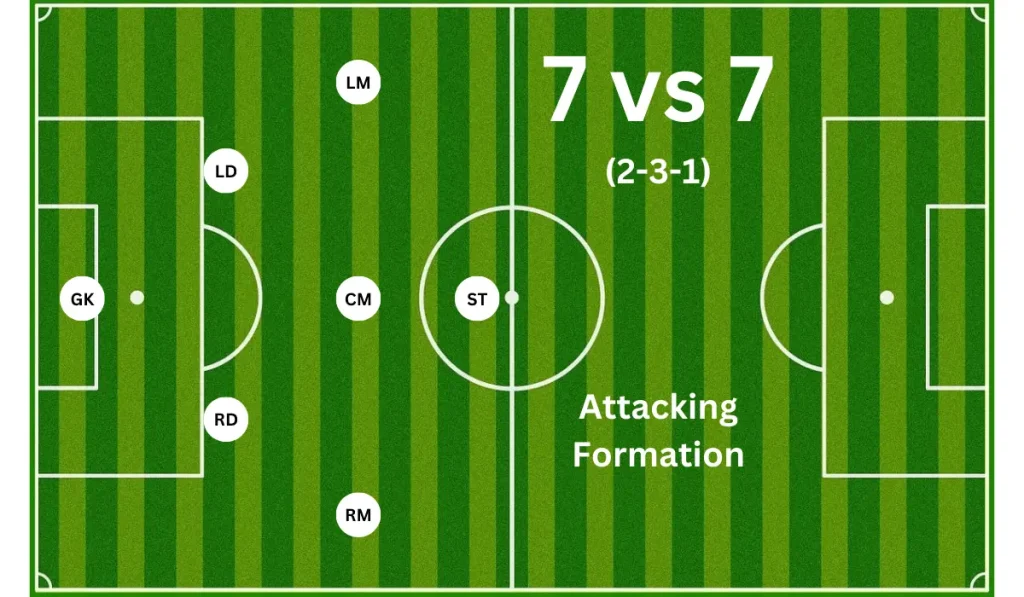
The 2-3-1 lineup provides strength through the midfield:
With three midfielders, you can dominate possession and retain the ball well. The midfielders should utilize quick passing and constant movement to create triangles. This also allows them to support both offense and defense easily.
The lone striker will need to work hard and be dynamic to put pressure on the opposing back line. Having active midfielders joining the attack gives the striker passing options in the final third.
3-2-1 Formation
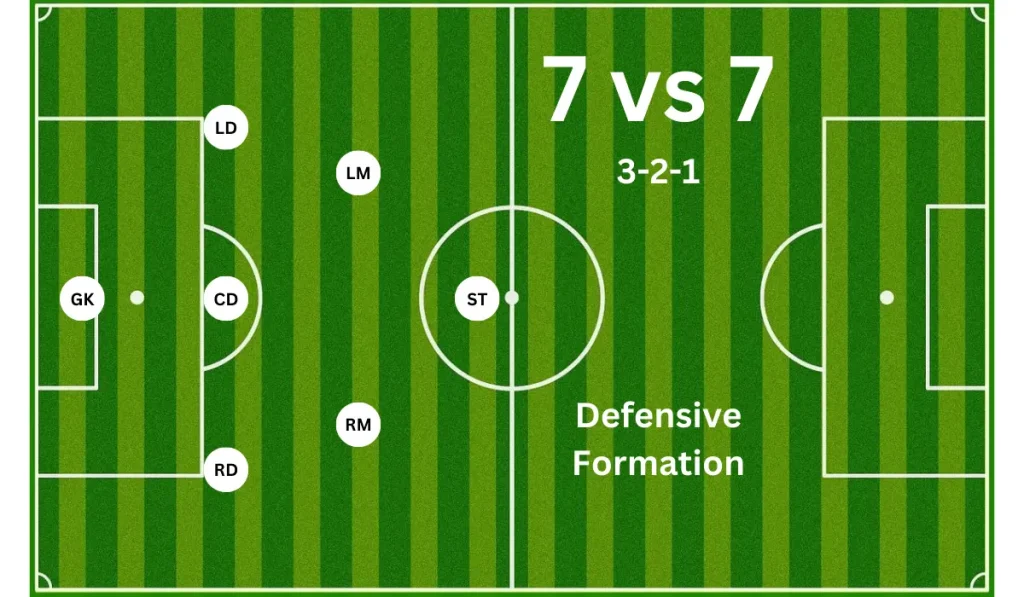
Similar to the 2-3-1 but with an extra defender, the 3-2-1 emphasizes defense a bit more:
The three defenders allow your team to absorb more pressure while remaining organized at the back. The midfielders again play a crucial role providing a presence centrally on both sides of the ball.
With only one striker, quick counterattacks will need to be precise. Overall, the 3-2-1 formation provides excellent defensive stability while still enabling midfielders to get forward as needed.
2-2-2 Formation
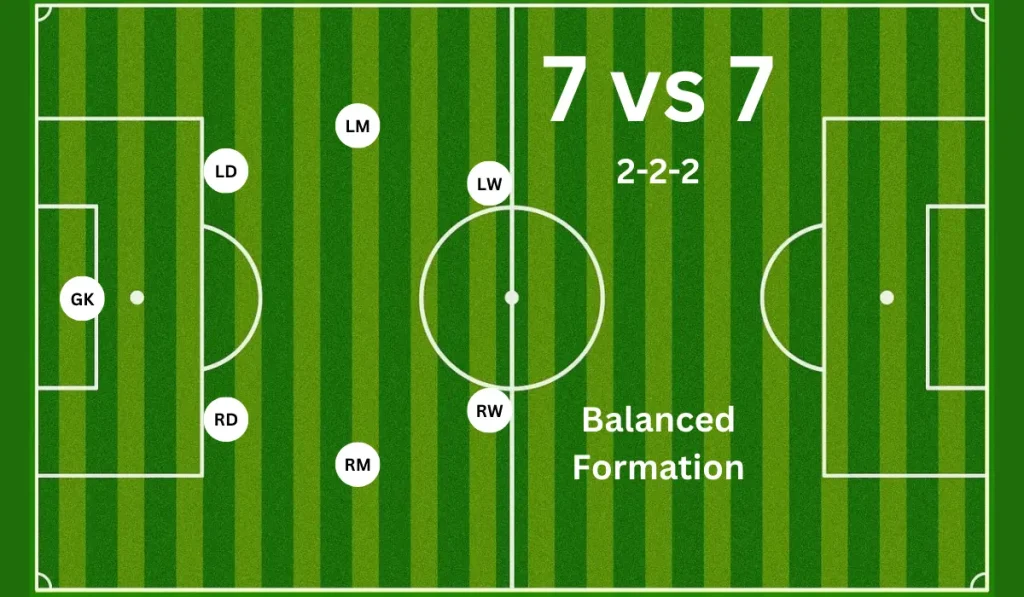
The 2-2-2 is a balanced approach:
Playing with two strikers allows you to take advantage of the no-offside rule and put constant pressure on the opponent’s defense.
The midfielders and defenders will need to read the game well and decide when to step or drop to support based on where the ball is. This formation relies on intelligent positional interchange and communication.
There are certainly many other variations to experiment with in 7v7 indoor soccer. The key is finding the right fit based on your personnel’s strengths and preferred style of play.
Possession vs. Counterattacking Styles
Most indoor soccer formations can be categorized based on either a possession-based approach or a counterattacking style.
Possession
Formations with 3+ midfielders will allow you to better control possession. The key is quick, triangular passing combined with smart off-ball movement into open space.
The 3-2-1 is a good example of a possession-oriented indoor formation. Maintaining the ball limits your vulnerability on defense.
Counterattacking
Formations with 1-2 midfielders require you to absorb more pressure defensively. But the tradeoff is exploding forward on the counter with your striker(s) leading the charge.
The 2-1-2 is a classic counterattacking indoor formation. Inviting pressure before hitting quickly on the counter can lead to high-quality scoring chances.
The right indoor soccer formation provides an excellent foundation. But it must be executed with organization, communication, and intensity in the rapid back-and-forth nature of the indoor game.
Overview of Indoor Soccer Rules
Before diving into formations, it’s helpful to understand some of the key rule differences between indoor and outdoor soccer:
These variations from outdoor soccer have several implications on strategy and formations:
Conclusion Of Soccer Formations Indoor
Forget rigid lineups and predictable plays – indoor soccer formations are a dance of adaptability, where defense morphs into attack and walls become launchpads for blistering counters. Unlike the sprawling fields of outdoor soccer, this court demands a different kind of magic: formations that pirouette between offense and defense with the grace of futsal maestro Alexandro “Cubo” Moreno.
Sure, unlimited substitutions and frenetic pace make flexibility key, but don’t underestimate the power of a solid game plan. Think Baltimore Arena’s legendary defensive wall, a fortress built on tactical discipline and anchored by the impenetrable Gustavo Salles.
Or picture San Diego Sockers’ dynamic midfield, a three-headed hydra-like Leonardo de Oliveira, Christian “El Mago” Gutierrez, and Franck Tayou, weaving magic and controlling the tempo like seasoned puppeteers.
But here’s the secret sauce: the “perfect” formation doesn’t exist. It’s a puzzle you and your team solve together, analyzing strengths, weaknesses, and even your opponents’ tactics. Remember, Xavi Simons of Barcelona Futsal didn’t become a midfield maestro overnight – it took dedication, experimentation, and building chemistry with his teammates.
So, don’t just memorize formations, master the art of adaptation. Be that chameleon defender shifting from wall-hugging sentinel to counter-attacking dynamo. Become the midfielder who morphs from playmaker to ball-winning warrior. Embrace the fluidity, the constant dance between strategy and instinct.
This is your invitation to unlock the secrets of indoor soccer formations. Experiment, analyze, and most importantly, have fun! Because in this beautiful game, teamwork and adaptability are the true keys to victory. Go forth, conquer the court, and write your own epic indoor soccer story!
FAQs of Formation in Indoor Soccer
1. What are the main differences between indoor and outdoor soccer formations?
The reduced numbers and smaller field sizes are the biggest differences. Formations focus more on balance rather than defined positions. Counterattacking is also more prominent with no offsides.
2. What are some important indoor soccer strategies beyond formations?
Quick passing, using the walls effectively, communication, and flexibility/positional interchange are some key strategies in the fast-paced indoor game.
3. How many players are on each team in indoor soccer?
Most commonly 6, 7 or 8 including the goalkeeper. Professional leagues are typically 6v6. Recreational leagues sometimes use 7v7 or 8v8.
4. Is futsal the same as indoor soccer?
They are similar small-sided indoor games, but futsal is played on a hard court surface, while indoor soccer uses artificial turf or carpet. Futsal is 5v5 with no walls.
5. What experience level is needed to play indoor soccer?
The recreational leagues are perfect for beginners! Indoor is great for honing fundamentals in a fast-paced environment. No prior outdoor experience is necessary.
